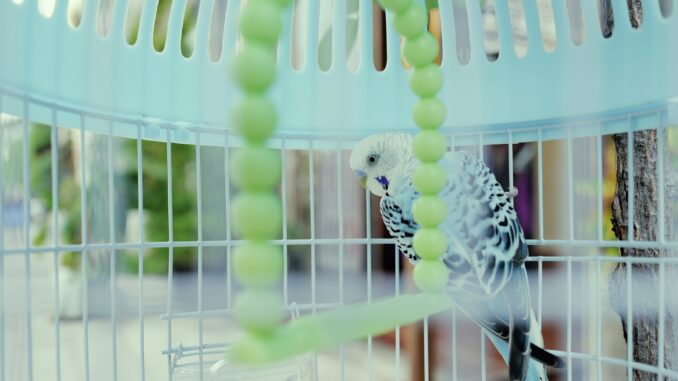
Creating a healthy, stimulating, and safe environment for your pet bird is essential for its well-being. Birds are intelligent, social creatures that require mental and physical enrichment to thrive in captivity. In this ultimate guide to enriching your pet bird’s environment, we will explore how to set up the perfect cage, choose engaging toys, and incorporate activities that mimic your bird’s natural behaviours. Follow these expert tips to ensure your feathered friend leads a happy, healthy life.
Why Enriching Your Pet Bird’s Environment Matters
Birds in the wild spend much of their day foraging, socializing, exploring, and flying. In captivity, lack of stimulation can lead to boredom, stress, and even destructive behaviors like feather plucking or excessive screaming. By enriching your pet bird’s environment, you encourage natural behaviors and provide mental and physical challenges that improve overall health.
Environmental enrichment improves:
- Mental stimulation and problem-solving skills
- Physical exercise for strong muscles and feathers
- Emotional well-being and reduced stress
- Social interaction and bonding
- Longevity and quality of life
Setting Up a Stimulating and Safe Cage Environment
The foundation of enriching your pet bird’s environment starts with its living space. A thoughtfully arranged cage will offer safety, comfort, and plenty of opportunities for exploration.
Choosing the Right Cage
- Size Matters: Opt for the largest cage possible for your bird species. Larger cages allow space for flying, climbing, and playing.
- Bar Spacing: Ensure bar spacing suits your bird’s size to prevent injury or escape.
- Material: Use durable, non-toxic cage materials that are easy to clean.
Cage Placement
- Place the cage in a well-lit, draft-free area with moderate room temperature.
- Position it at eye level to encourage interaction with household members.
- Avoid kitchens or areas with fumes or heavy drafts.
Perches for Foot Health and Variety
- Provide perches of varying diameters, textures, and materials such as wood, rope, and natural branches.
- Natural wood branches replicate tree limbs and offer birds a chance to grip differently, strengthening their feet.
Feeding Stations and Water
- Offer fresh food and water daily.
- Use multiple feeding stations to encourage movement.
- Incorporate foraging opportunities by hiding treats in food puzzles or among climbing toys.
Selecting Toys That Encourage Natural Behaviours
Toys are crucial for enriching your pet bird’s environment because they promote mental engagement and physical activity. Choose toys that encourage foraging, chewing, climbing, and problem-solving.
Foraging Toys
Foraging is an instinctive behavior where birds spend time searching for food. Foraging toys challenge your bird’s intellect and keep it occupied.
- Puzzle feeders with hidden treats
- Shreddable paper or palm leaf toys with hidden seeds
- Foraging boxes with natural materials like shredded wood or straw
Chewing and Destructive Play Toys
Many birds have a natural urge to chew, which is important to maintain beak health.
- Wooden chew toys made from bird-safe wood
- Rope toys composed of cotton or sisal fibers
- Natural seed pods or coconut shells
Climbing and Swinging Toys
Physical exercise keeps your bird fit and prevents obesity.
- Ladders, ropes, and swings
- Climbing nets or vines
- Modular play gyms outside the cage for extended exercise time
Noise and Sound Toys
Some birds love making noise or mimicking sounds.
- Bells and chimes
- Toys that make soft crunching or rattling sounds
Activities to Mimic Natural Behaviours
In addition to the cage and toys, enriching your pet bird’s environment includes interactive activities that stimulate natural instincts.
Flight and Exercise Time Outside the Cage
- Allow supervised, free flight time in a safe room regularly.
- Use harnesses for outdoor exploration if appropriate.
Social Interaction and Training
- Talk to your bird regularly to build trust and social bonds.
- Teach tricks and commands using positive reinforcement.
- Rotate toys and cage setup frequently to maintain novelty.
Environmental Enrichment Through Sensory Stimuli
- Provide natural sunlight exposure or full-spectrum lighting.
- Play nature sounds or bird calls to simulate natural environments.
- Offer bath opportunities with shallow water dishes or mist sprays.
Nesting and Breeding Behaviors
- For species prone to breeding behaviors, provide nesting materials like hay, coconut fibers, or soft paper.
- Monitor nesting to avoid stress or aggression.
Safety Tips for Enriching Your Pet Bird’s Environment
- Avoid toys with small parts that pose choking hazards.
- Steer clear of toxic materials like zinc, lead, or treated wood.
- Regularly inspect toys and cage accessories for wear or damage.
- Prevent access to household dangers such as ceiling fans, toxic plants, or fumes.
Conclusion
In summary, enriching your pet bird’s environment is the key to a happy and healthy life for your feathered companion. By carefully selecting a cage setup that encourages natural behaviours, providing a diverse range of engaging toys, and incorporating activities that mimic the wild, you support your bird’s mental and physical well-being. Remember to prioritize safety and change up the environment frequently to keep your pet bird curious and stimulated. With these expert tips, your bird will thrive in a vibrant, safe, and enriching home.
If you found this guide helpful, be sure to explore more tips and resources on bird care to keep your pet bird content, active, and healthy. Enrich your pet bird’s environment today and see the positive impact it makes on your beloved companion’s life!